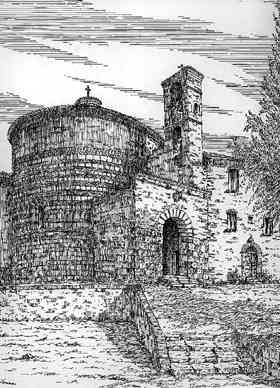| A
critique of Nino Gorni's art entails entering into a concept of art characterised
by great depth and feelings. It arises from direct contact with the human
essence to go on to recounting feelings of primordial nature. These appear
as genuine in the immediacy of Nino's communication both in the individual
figures as well as in the portraits of groups. In the latter, each element
of the composition corresponds to a precise emotion which then becomes an
integral part of the suggestive whole. Gorni's technical procedure reveals
two interesting aspects of his work. The first is the skeleton of the painting.
It is realised with effective shapes: incisive, sober and extremely elegant
in rhythmic development of form, which in itself is already highly expressive.
The second concerns the colours of the background. The process here is that
of laying a thin veil, a mist, created with intangible superimpositions.
Extreme finesse is achieved through the sobreity of tones in vibrantly intense
colours and exquisite matchings. An excellent basic mastery underlies the
works, essential to the artistic development arising from it. Everything
focuses into a single whole in its message of humane sensibility. |
|
|
|
The
execution of the paintings belies agitation, though balance is studied to
the utmost degree. The contents are dramatic. The condition of the human
beings portrayed is being experienced to the utmost degree, moved, as it
is, by internal and external pangs. This condition grows in times of anxiety,
of uncertainty, of indifference, to return to pain. It is this last feeling
which is the most rooted and the most apparent on the faces marked by the
tragedies of life. As a result, in Nino Gorni's work we can perceive a continuous
turmoil. It comes from a profound analysis of the soul. From this an idea
is born, an idea which turns into a concrete vision. That's why we see a
talent for things intimate and of so many facets as to be romantic in nature.
But this is not all, for through the very wealth of symbols, valuable for
their contents, does Gorni's work reach our intellect. His artistic personality
is thus complete and has reached its expressive maturity. One sees this
in the strength of spirit of the many people portrayed. It is this inner
strength, the result of universal components, that bears man up. The greatness
of his compositions (see for example, "The
Anxiety of Waiting",
or "Fight
in a Public House")
also add suggestive power to what I have said. The
above paintings depict a crowding of figures rendered with rare psychological
introspection in their different postures and expressions. It is all based
on an interpretation of life and its course, of fundamental importance in
understanding how original is the transfiguration of reality here into a
more conscious quest for truth. The same characteristics appear in paintings
like "Provisioning".
The four women here correspond very well to Nino Gorni's inquiry into human
nature. They are pictured in their environment and are an integral part
of it and of its atmosphere. These are qualities that appear in all of the
Brescian painter's works. For, although he depicts people of the sea and
their vicissitudes, or man's hard labour, as in "The Rock Cleaver", Gorni
is not averse to symbolic representations denouncing the emptiness of the
contemporary world. Paintings like "The False Culture", in fact, unveil
vast problems. For the whole of Gorni's art poses problems with its topicality.
It does so, consciously, and through the power of its composition and of
its idealism, all of which comes from the past.
Alberto
Morucci
|



